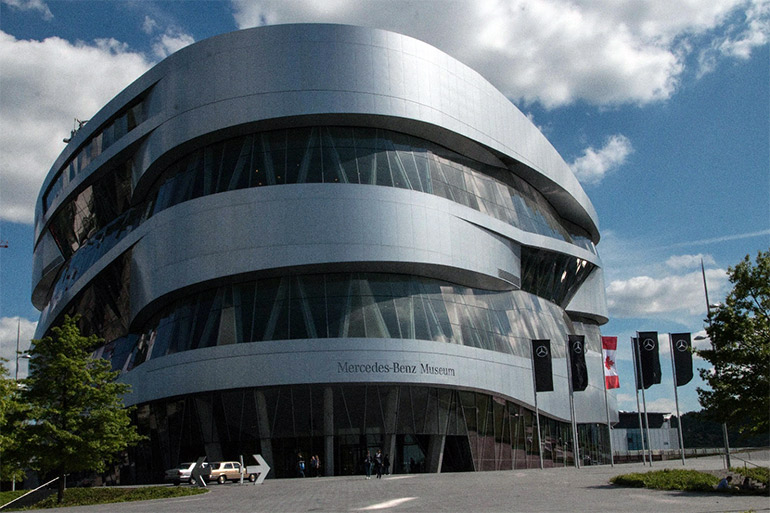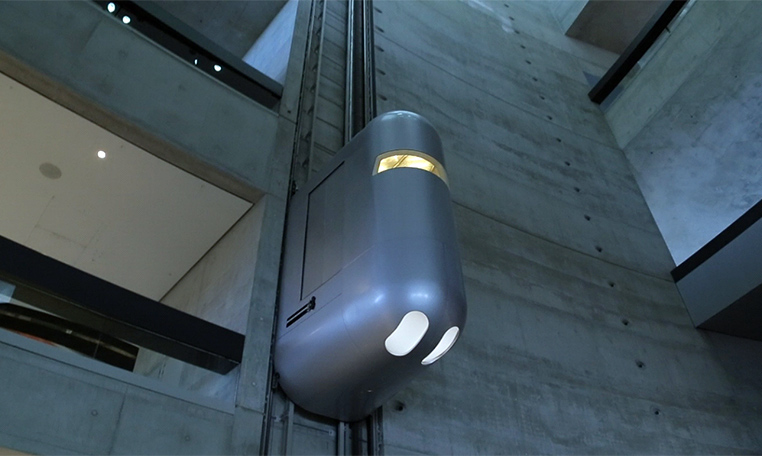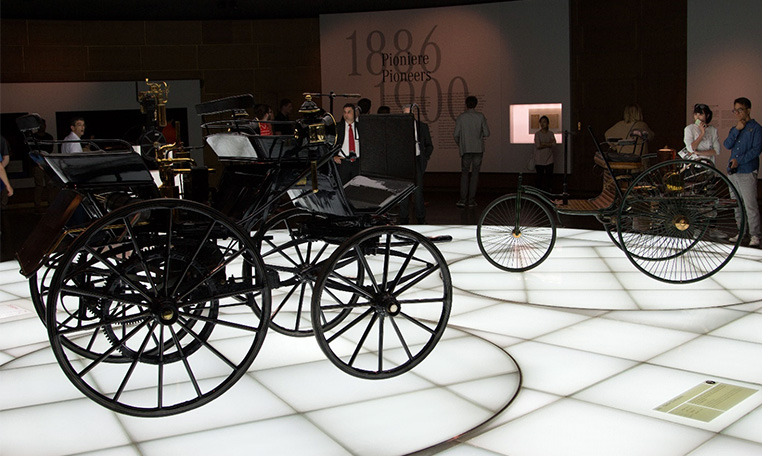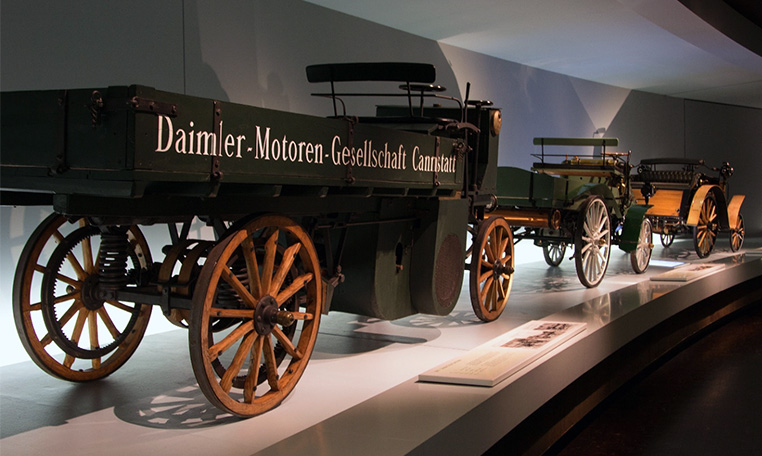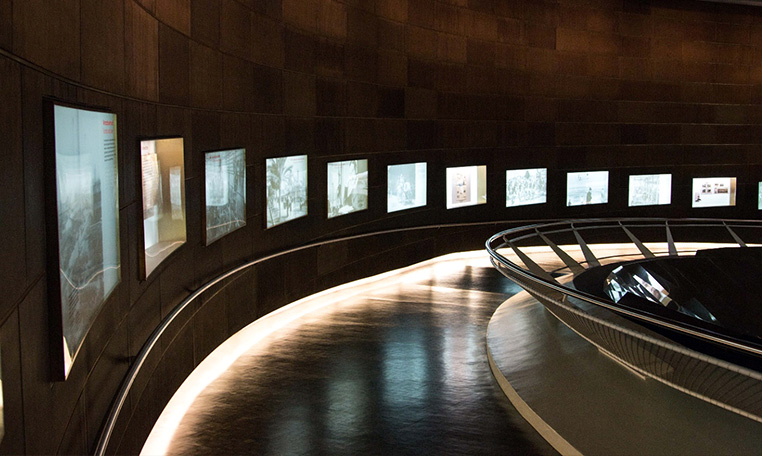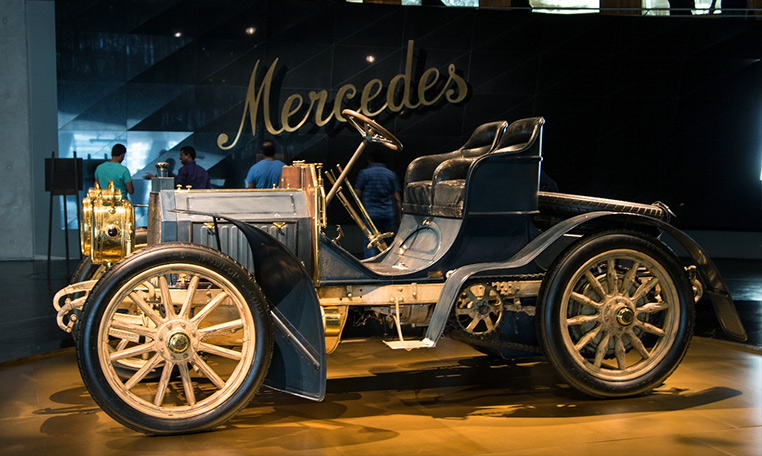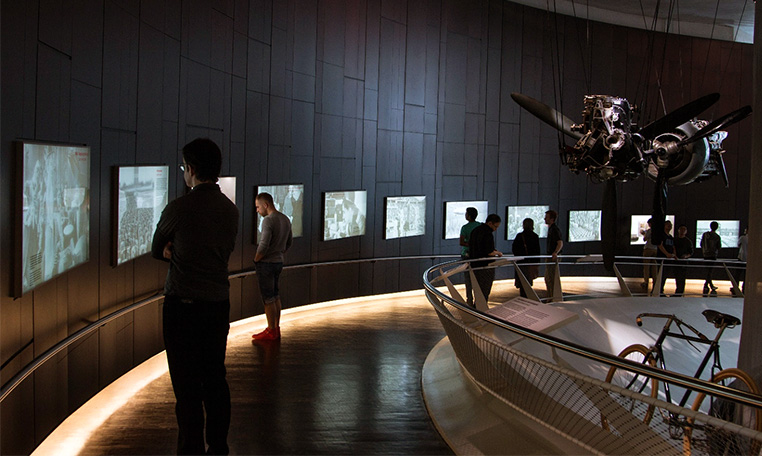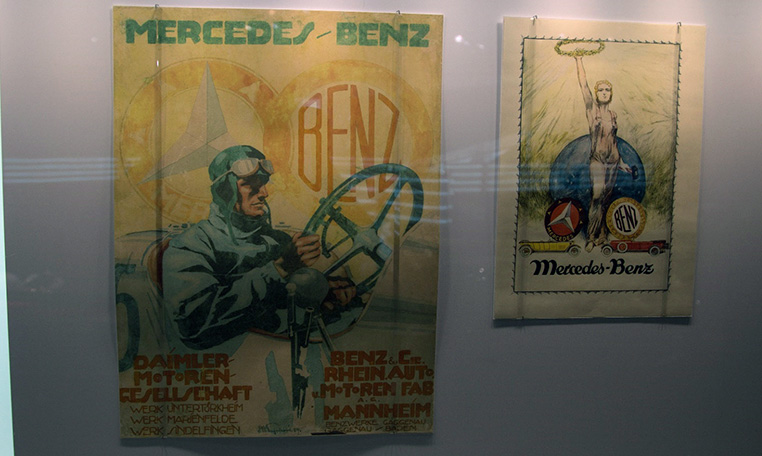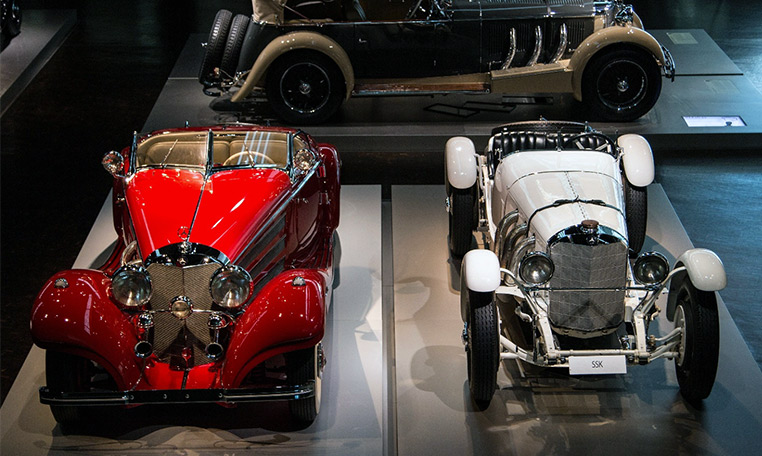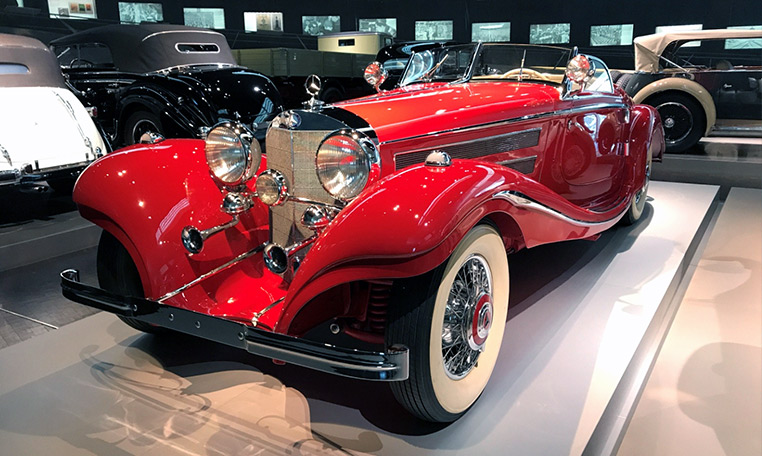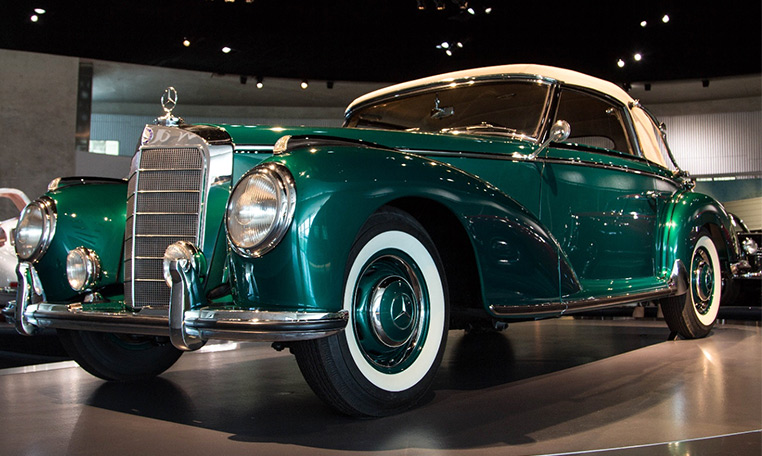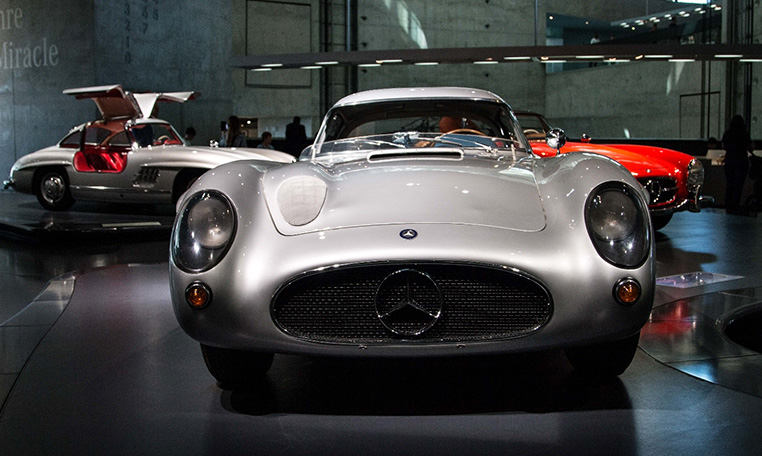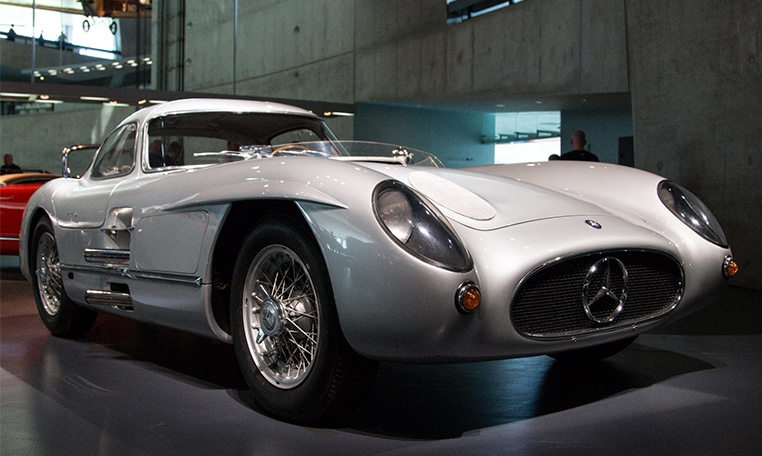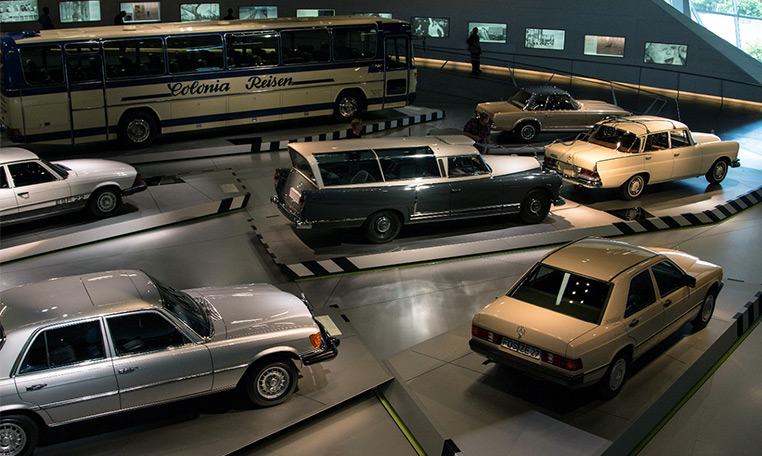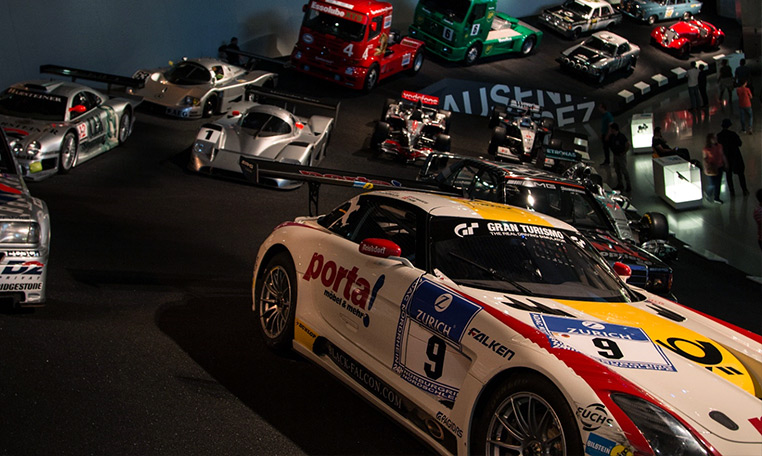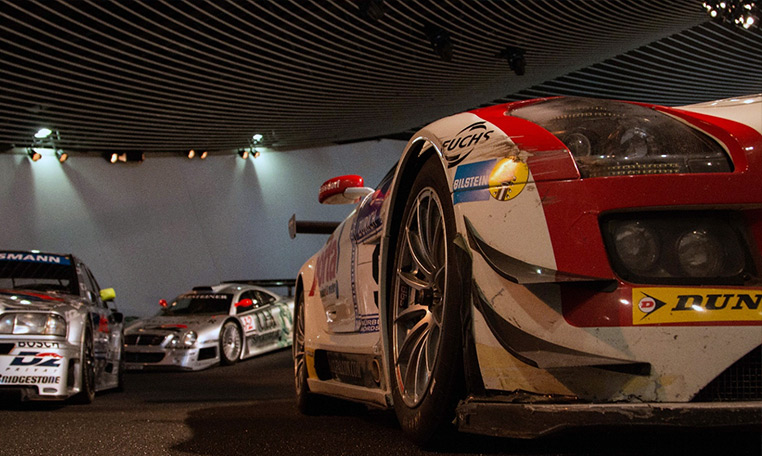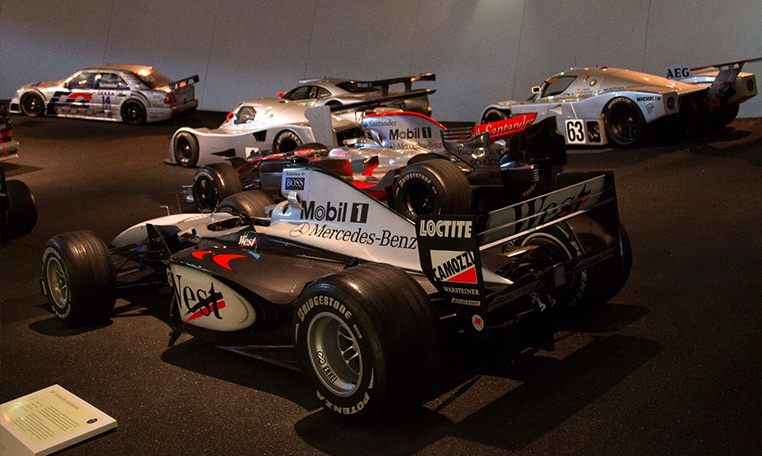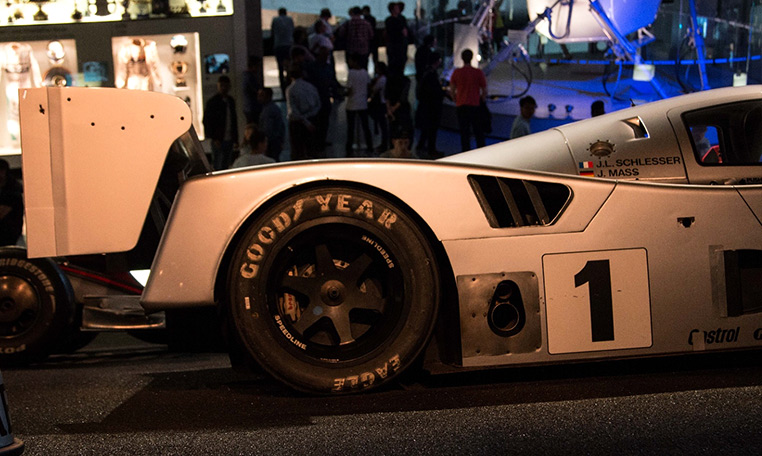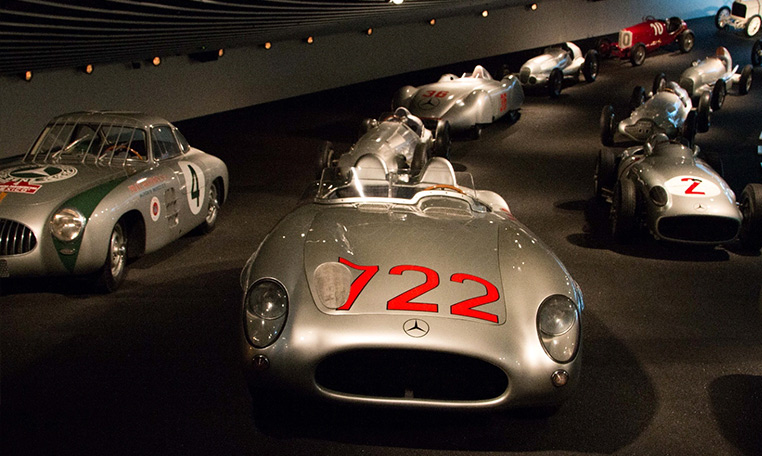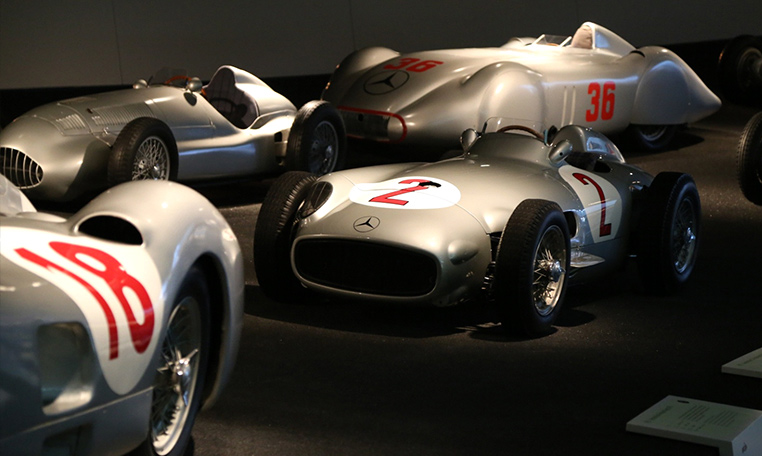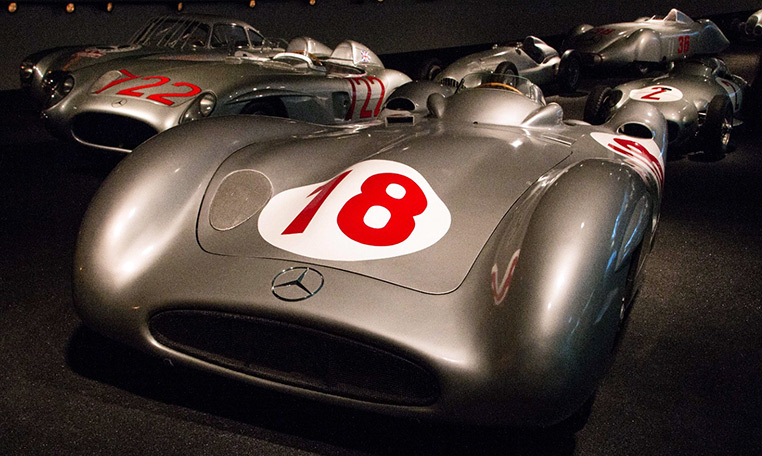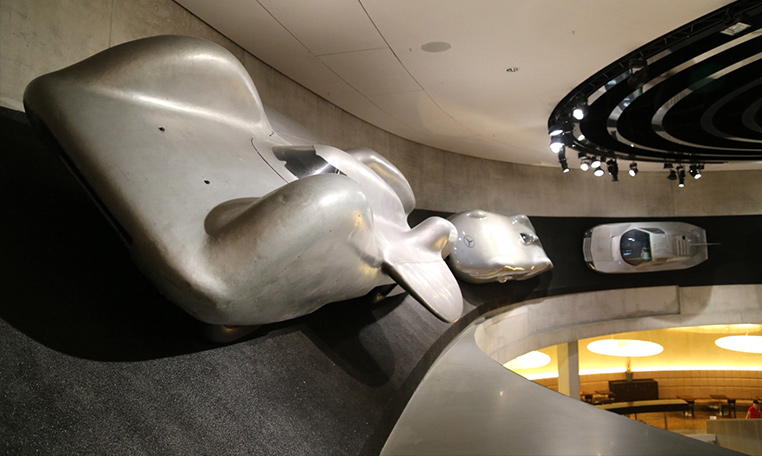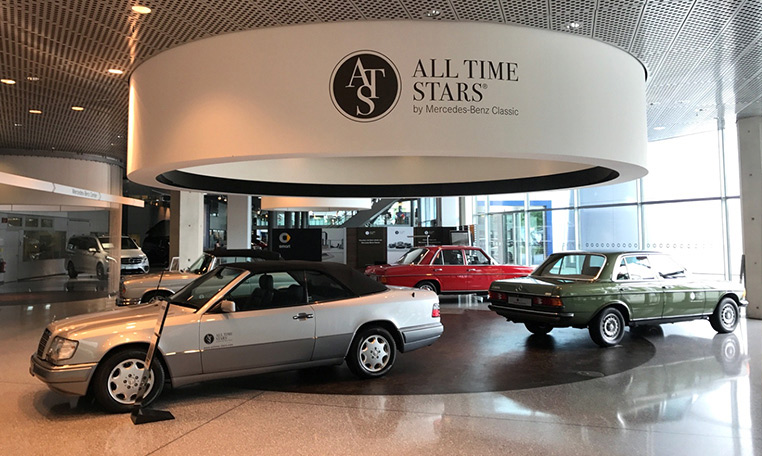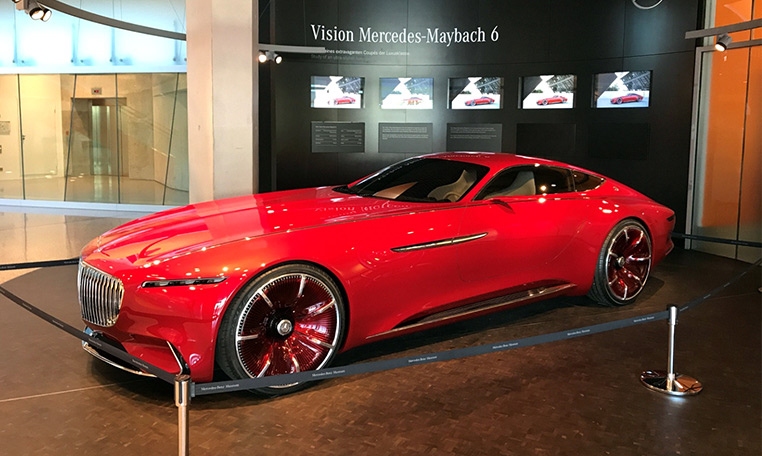Over eight million people have visited the Mercedes Benz Museum in Stuttgart since it opened in 2006. Recently, Speed Journal principal Jeff Francis visited and took his own walk through Mercedes Benz history.
Whereas some other automotive museums focus on their own histories and landmarks, the Mercedes Benz Museum interweaves historical events occurring simultaneously as its own history. The effect is remarkable. The clear message is not just that Mercedes Benz has a significant history of its own, but rather that the history of Mercedes Benz is inextricably intertwined with world history. It is a message of depth, significance, relevance, perseverance, purpose and of strength.
Like all visitors, Jeff was transported in a time capsule (otherwise known as an elevator) to the top floor where the sound of modern day traffic receded in favor of horse clip clops where the company first was born. He then made his way down the ramps of history to return to modern times on the entrance level.
Francis started his tour in the late 1800s with the very first motorized horseless carriages. Karl Benz and Gottlieb Daimler separately built the first motorized vehicles to sell to customers in 1886. The one cylinder Benz Patent Motorwagen features three wheels because Benz was unsatisfied with steering systems for four wheels.
The museum illustrates the quick evolution of engines and vehicles. Engines became more powerful and sophisticated. Vehicles became larger, more reliable, and capable of industrial applications such as fire trucks and delivery trucks.
The tour continued along the downward sloping ramp around the perimeter with display panels and cases on the walls. Descriptions of Benz and Daimler operations, such as original documents relating to sales, production and trademarks weave between world history events such as the discovery of X-rays, expansion of telephone networks, the beginning of large scale tourism and the first Tour de France.
One display acknowledged the evolution of gentlemen drivers who enjoyed racing automobiles. That might otherwise be unremarkable but for the story of Emil Jellinek who was a Daimler customer and then a sales agent for the company. He wanted to prove the quality of the cars he sold in races, so he convinced Daimler engineer Wilhelm Maybach to build him a race car. Jellinek named the car after his daughter, raced and won in Nice, France in 1901. His daughter’s name? Mercedes.
The 1900s room featured five cars, but the most significant sat in the center – the 1902 Mercedes Simplex 40PS. It was built by Daimler and is the oldest Mercedes still in existence. It is an elegant car with four wood white spoked wheels, minimal blue bodywork, black seats, big brass headlamps, and a spare tire mounted at the ear – and hosts a four-cylinder engine that produced 40 horsepower and a 50mph top speed. It is considered the baseline for subsequent models through the mid and late 1900s.
In 1909, the company with a successful brand name of Mercedes adopted the now-famous three pointed star for its logo. Lore has it that Gottlieb Daimler told his wife very early in his career that a star would shine one day over his factory as a mark of success. After his death, two of his sons resurrected the idea. The three-pointed star was intended to represent a vision of mobility “on land, on water and on air.” Touches were added later to refine the design but the iconic three-pointed star was born.
Descending into the next room, the tone changed. The years from 1914 to 1945 were obviously pivotal. World War I required Benz and Daimler to convert to war-time production of mostly trucks and airplane engines. Several large Benz airplane engines hang from the ceiling, often used to power reconnaissance aircraft.
In the aftermath of the World War I, Benz & Cie and Daimler began a collaboration in 1924 at the behest of their bankers before formally merging in 1926 to create Daimler-Benz AG. A display case not only described this history, but also included the first two advertisements used by Benz and Daimler as they began their collaboration.
The historical panels for visitors around the ramp descending into the main display area acknowledged both World Wars and the companies’ involvement in supporting the war efforts with production. It is presented with candor, as a matter of historical fact. The difficulty of war is a striking contrast to some of the most beautiful vehicles ever made that sit only feet away.
The 1920s and 1930s featured large cars with big engines sitting under long hoods. Cars from this period are unmistakable – sculpted fenders, chrome accents and large headlamps, marvelous interiors and gauges, and large wire wheels.
Perhaps one of the most iconic is the 1936 500K Special Roadster. The Museum’s example is bright red with light tan interior. Eight cylinders created about 100 horsepower and a top speed of 100mph. With such a shape, the car has presence. It was the top of the line at the time and incredibly expensive. The model permitted clients to order among eight different body styles but the special roadster is the pinnacle.
A green 1954 Mercedes 300 Cabriolet welcomes visitors into the display area for the 1950s. The styling bears some echoes of the 1930s but is a sign that Mercedes Benz design language was changing. It should be no surprise that the rest of the display area for the 1950s is dominated by the 300SL platform.
A silver 300SL gullwing with its doors opened to the sky sits alongside a red 300SL roadster. These are million dollar cars and considered core building blocks for most automobile collections for museums or private collectors. They are iconic and well known.
Perhaps less well known but more stunning is the 1955 300SLR coupe which was developed for racing in the 1956 season. Stripped of the bulky front and rear bumpers found on the 300SL road cars and enhanced with more aggressive styling cues, the 300SLR has a more pure shape. Sadly, the company ceased all motor racing activities at the end of the 1955 season, so the car never turned a wheel in competition. The head of the testing department, Rudolph Uhlenhaut, used the car as a company car – quite a perk of the job. In light of its owner, the car picked up the nickname of the “Uhlenhaut Coupe.”
Next stop down the sloping ramp was a feature on road cars from 1960 through 1982. World history panels on the walls guide the way to the next stop. The message of continued technological development was communicated through a crème 1960 Mercedes 220S sedan positioned directly in front of a 1964 Mercedes 300 wagon. What could be special about a mid-1960s station wagon? This is a one-off built for testing purposes. Loaded with data recording equipment and connected to the 220S with cables, the 300 Messwagen (or “Measuring Car”) was used for testing of new cars. It is a reminder that modern day real-time wireless data acquisition tools had a humble start when computers were very new.
Between levels, windows offered quick glimpses of the roads around the museum and the Untertürkheim Mercedes werks next door. The visual of the plant and the surrounding transportation infrastructure only serves to emphasize the themes inside the museum.
A final display of alternative fuel vehicles spanned from a small A-class to a larger sedan, wagon and utility truck to an all-electric Mercedes SLS gullwing coupe. In reality, the display room served as a mere speed bump on the way to the seventh “legend” room – otherwise known as the “Silver Arrows – Racers and Records” room – which is the massive display of Mercedes Benz racing history.
About 30 race cars of all shapes and sizes are arrayed on a long stretch of banked black surface intended to evoke a race track. Several Formula One cars, German Touring Cars, a 2014 SLS sportscar, mid-1980s Sauber sportscars, a mid-1990s AMG CLK-GTR sportscar, two racing semi-trucks, and racing sedans comprised the first half of the room. The 2014 Nürburgring 24 hour SLS GT3 winner has been preserved with all of the various scrapes and scratches earned during the run to the checkered flag.
Guests can walk above and below the banked display, allowing a close look at different cars from different angles. For a racing enthusiast, it is a remarkable and impressive display. For a publication called “The Speed Journal,” it felt like the highlight of the trip for Francis.
The visual presentation was matched only by the soundtrack. Every five minutes a bright spot light highlighted a particular car and engine sounds for that car burst from the loudspeakers. The grumble and roar of a racing truck is a sharp contrast to the wail of a Formula One car as the surrounding sound wave tricks your ears into thinking the car is passing right behind you. Several simulated hot laps were enough to suggest what it might have been like to stand trackside and pressed up against the fence, straining to see the coolest and fastest cars of that period.
The display area also included several race cars with body panels removed, but still suspended and floating around the car. The effect was to give a stronger appreciation for the packaging mastery that engineers and designers undertake to manage the balance between aerodynamic shapes on the surface and production of power and grip throughout the internals.
Wall display units were filled with trophies, driver suits and other memorabilia from decades of competition. The displays subtly link the trophies with the cars that earned the hardware.
A second half of the banked display started with the Silver Arrows of the 1940s and 1950s and stretched back into the early 1900s. A 300SL gullwing coupe with vertical bars mounted across the windshield to protect the drivers from stray animals sat next to more pure-bred racing cars – the famous 1955 Mille Miglia 300 SLR winner #722 and a pair of W196 examples in monoposto and sportscar versions.
The W196R Streamline sportscar variant was The Speed Journal’s overall favorite example in the museum. The fascinating history of Juan Manuel Fangio winning two back to back World Championships in the car was extremely impressive. The slippery aluminum body just overwhelms with its timeless and seductive beauty.
Books can (and have) been written about the significance of each of these cars, both for Mercedes history specifically and auto racing more generally. Each would be a main feature in almost any museum around the world. To have them all assembled together was an unbelievable experience.
Exiting the main display area and returning to the main level, one can’t help but notice the several silver aerodynamic cars mounted on the walls. Two were built in 1938 and 1939 and powered by V-12 engines. One reached an average speed of 269.9 mph on a public road over a flying kilometer with two runs. The other – ironically designed by Ferdinand Porsche – was targeted for 3000 horsepower and 373 mph, but World War II intervened and the car was not completed and never ran.
Flush with excitement from his visit, Francis headed to the gift shop on the lower level. Many visitors are content with taking home a shirt, a keychain, a book or a die-cast model. He somehow bypassed those trinkets and ended up at the All Time Stars display area.
For those who would like their own piece of the Mercedes Benz legacy, the All Time Stars operation has various vehicles for sale. Operated by Mercedes Benz Classic, vintage Mercedes automobiles are available for sale. For example, a stunning 280SL that had undergone a concours level restoration by Mercedes was priced at €325,000. Pricey, but likely better than new and it also came with a 12-month Mercedes Benz warranty. Other various Mercedes vehicles were for sale at lower price points without the benefit of a concours restoration or the 12-month warranty. Francis ultimately passed on the opportunity to take one home, but a bright red concept car on display caught his eye. Sadly, it wasn’t for sale…
The Speed Journal and Jeff Francis would like to thank the Mercedes Benz Museum for their hospitality to tour and film the museum.



